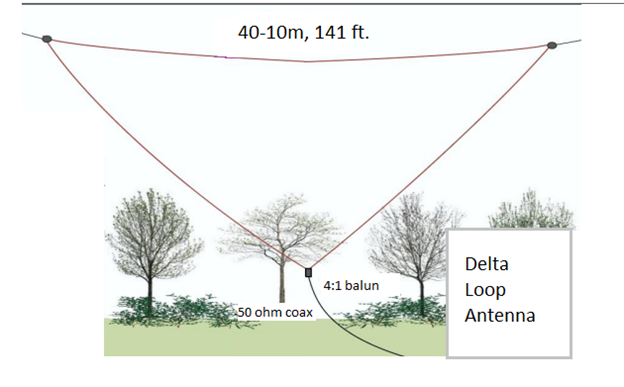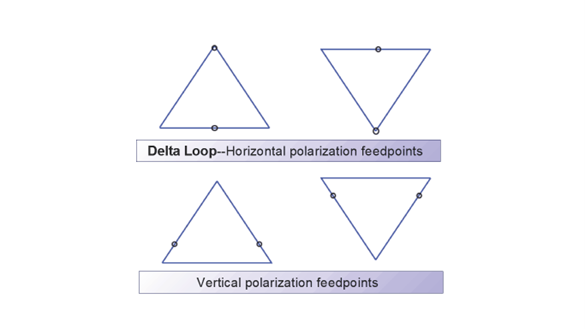Looking for a wire antenna that’s inexpensive, easy to build, and works great for DX above 40m? A delta loop and its variants can make an effective single-band or multiband antenna. The larger dimensions of the loop increase radiation efficiency as compared to the typical half-wave dipole.
Shape Shifting
For those with limited space, the delta loop antenna offers a compact and space-efficient design. Its triangular shape allows it to fit into smaller areas, making it suitable for installations in urban environments or where space constraints are a concern. The delta with the point down is convenient for a rigid top support or strung between two trees like a dipole, and only requires a short feed line to reach the ground (see below). For shorter supports, the delta with the point up can be used.

A full-size delta loop, fed in the bottom corner, is a good low angle radiator and is a DX dream. This antenna can have up to a 3 dBi gain over a 1/2 wave center fed dipole, depending on height. It’s not only a great transmitting antenna but also a low-noise receiving antenna. The direction of radiation is broadside to the antenna—if the base wire of the antenna goes from north to south, the direction of gain will be east and west.
This simple broadband antenna is easy to construct, has gain similar or better than a dipole, and is generally tolerant of nearby objects. It can be erected in almost any configuration, provided the wires are well separated.
The Build
Using the formula 1,005 /freq. (MHz) gives the total size in feet. This is usually divided among the three sides, forming an equilateral triangle. When the antenna is horizontally polarized, it should be mounted as high as possible, but it can work well at low heights of 10-30 feet. They are quieter than a dipole or vertical, have a broader bandwidth, and slightly outperform a dipole antenna.
Delta loop wire lengths at mid-band
10 meters: 34.84 feet
12 meters: 40.29 feet
15 meters: 47.35 feet
17 meters: 55.47 feet
20 meters: 70.55 feet
30 meters: 97.19 feet
40 meters: 140.56 feet
75/80 meters: 269.80 feet
160 meters: 528.9 feet
The feed point impedance of a delta loop in free space is approximately 100-120 ohms. When installed close to ground in the real world, the feed point impedance can vary from 50-240 ohms depending on configuration, orientation, and choice of feed point. Because of this, a feed point matching system is required for multiband operation.
There are multiband delta loop designs available that use an equilateral triangle with apex up or down and feed points on the bottom, side, and corner. Each variation changes the characteristics slightly regarding the impedance, gain, polarization, pattern, and, from the DX point of view, the takeoff angles.
When using coaxial cable, a 4:1 balun is added for a multiband antenna. Sometimes ladder line is used at the feed point in addition to a ladder line matching stub on the opposite end. Tuners, either at the base of the antenna or in your ham shack, can also be used.
Monoband delta loops are also an option. They can tune up on its second harmonic at a higher frequency: 160m loop on 80m, 80m loop on 40m, 20m loop on 10m. The Bushcomm Delta Diamond is made for 60m but can be adjusted for other bands.
Perhaps the biggest decision is which polarization to use. The below image shows the typical feed points for horizontal and vertical polarization. Vertical polarization is preferred for working DX.

Shortened Delta Loop
A 40m delta loop measures roughly 140.5 feet, making each side about 46.8 feet. Several articles about delta loops mention that a reduction to .75 wavelength can be done while still maintaining good results. Given these figures, it could be reduced to a total length of about 105 feet, with each side 35 feet long.
Searching the DX Engineering catalog for commercially-made delta loops, I found two that had compact versions. The first was Chameleon’s Tactical Delta Loop, a portable antenna incorporating a matching transformer and tunable from 3.5 to 54.0 MHz with an ATU. EAntenna’s HF Rotatable Delta Loop has 1 and 3 kW models intended for base station use and include a matching unit at the antenna mount. They’re tunable from 30 through 6 meters—wide range tuners also provide operations on 40 meters.
Shape of Things to Come
Delta loops are good performers, cheap, simple, sometimes portable, and one more option to get on the air. Put the force of the delta loop behind your signal.

